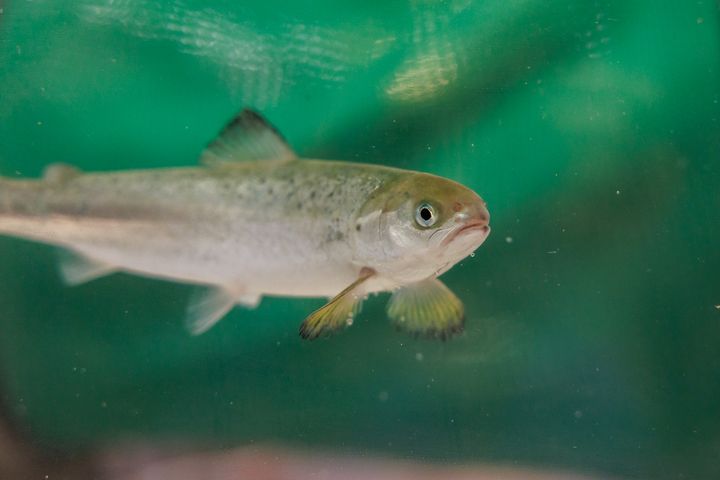New Findings on Salmon's Response to Hydrogen Sulphide in Land-based Fish Farms
Researchers from Nofima and international collaborators have made important discoveries about how Atlantic salmon react to prolonged exposure to low levels of hydrogen sulphide (H2S) in recirculating aquaculture system (RAS).

The study, published in Ecotoxicology and Environmental Safety, provides valuable insight for land-based salmon farming. The results could have significant implications for fish health and welfare in these systems.
Hydrogen sulphide is a toxic gas that can form in recirculating aquaculture systems (RAS), particularly at higher salinity levels. Even low levels of H2S have been linked to health problems and mortality in salmon. The recently published study looked at how salmon are affected by being in water with low amounts of hydrogen sulphide over an extended period, which can occur during normal production in RAS.
Researchers from Nofima have investigated how salmon mucosal surfaces (i.e. skin, gills, and nose), which are the first line of defense against environmental threats, react to prolonged exposure to low, non-lethal levels of H2S.
One of the key findings that the researchers made is that when salmon are exposed to hydrogen sulphide, the gills and olfactory organ in particular react by activating genes that help the fish cope with stress and activate the immune responses. Another finding is that salmon mucosae have natural ability for detoxifying hydrogen sulphide. The researchers also identified several protein markers in the mucus from the skin and gills that can be used for non-invasive testing for H2S response.
"Our findings suggest that salmon can largely adapt to the low H2S levels we tested, without serious negative health effects," says project leader Carlo C. Lazado from Nofima, adding: "This is good news for the aquaculture industry, but also underscores the importance of careful monitoring and control of H2S levels in RAS facilities."
The results can contribute to better farming of Atlantic salmon in several ways. One of the most important points that the researchers highlight in the report is improved risk assessment and setting of limit values for H2S in RAS facilities. There is potential here for developing new standards to strengthen salmon's resistance to H2S exposure.
The study represents an important step towards more sustainable and efficient land-based salmon farming, with a focus on fish welfare and production quality. The findings are particularly relevant for land-based fish farms where H2S levels may be higher than in open sea facilities. By monitoring and controlling H2S levels, as well as implementing measures to strengthen the fish's natural defenses, farmers can ensure healthier and more productive fish.
Carlo Lazado will present more from this research at the conference Smolt production in the future 16 and 17 October 2024.
Keywords
Contacts
Reidun Lilleholt Kraugerud
Tel:48197382reidun.lilleholt@nofima.noCarlo C. Lazado
Tel:930 27 905carlo.lazado@nofima.nonofima.no/person/carlo-cabacang-lazado/Images

Links
About Nofima
The Norwegian food research institute Nofima provides research based knowledge and innovations for actors in all parts of the food systems.

Subscribe to releases from Nofima
Subscribe to all the latest releases from Nofima by registering your e-mail address below. You can unsubscribe at any time.
Latest releases from Nofima
Milliarder fra Havbruksfondet smører norsk kommuneøkonomi29.12.2025 07:00:00 CET | Pressemelding
Annethvert år kommer milliardene fra Havbruksfondet som kjærkommen hjelp for norske kommuner i pengenød. 2024 var et slikt år.
Three months shorter production time11.12.2025 07:00:00 CET | Press release
Selective breeding is a powerful tool to enhance desirable traits in fish and livestock - a fact well established in the industry. Now Manila clam has its own dedicated breeding programme.
Tre måneder kortere produksjonstid11.12.2025 07:00:00 CET | Pressemelding
At avl er et kraftfullt verktøy for å få fremgang i egenskaper man ønsker hos fisk og dyr, er kjent. Nå har teppeskjell fått sitt eget avlsprogram.
Potential for land based red algae25.11.2025 10:39:15 CET | Press release
How could Norway produce more food, utilise high nutrient levels in discharge water and create new businesses?
Potensiale for landbasert rødalge25.11.2025 07:00:00 CET | Pressemelding
Hvordan kan Norge produsere mer mat, rense utslippsvann og skape nye arbeidsplasser?
In our pressroom you can read all our latest releases, find our press contacts, images, documents and other relevant information about us.
Visit our pressroom